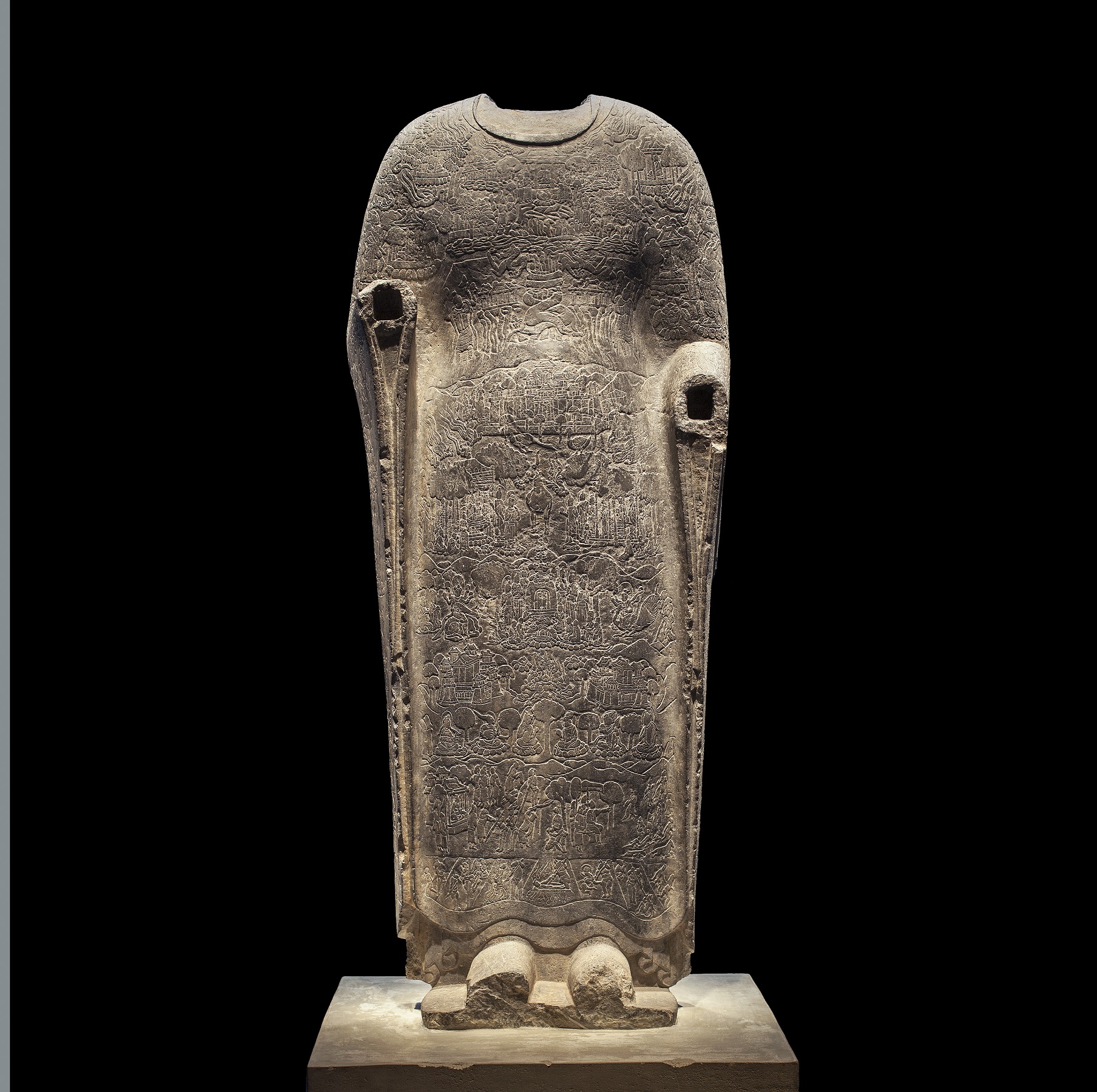Ashokaan Indian emperor from the Maurya dynasty who ruled from 268 to 232 BCE. He was a great patron of Buddhism.: an Indian emperor from the Maurya dynastya series of rulers from a single family. who ruled from 268 to 232 BCE. He was a great patron of Buddhism(bood-ihz-uhm) a widespread Asian religion or philosophy founded by Siddartha Gautama in northeastern India in the 5th century BCE..
bodhisattva(bo-dee-saht-vah) an enlightened being who chooses not to proceed to Nirvana but instead remains on earth to guide others in their paths toward enlightenment.: an enlightened being who chooses not to proceed to Nirvana(ner-vah-nuh) a spiritual state of perfect peace beyond selfish attachments to worldly possessions; reaching Nirvana frees one’s soul from the Buddhist cycle of birth, death, and rebirth. but instead remains on earth to guide others in their paths toward enlightenmenta moment of great wisdom and understanding; the highest level of consciousness, believed to be achieved through meditation and adhering to the basic moral teaching of Buddhism..
Brahman(brah-muhn) the highest caste among four social classes in Hindu India.: the highest caste among four social classes in Hindu India.
Buddha(bood-huh) literally, “Awakened One”; a being who has awakened to the true reality of existence and is thereby liberated from the cycle of birth, death, and rebirth. A Buddha teaches others the path to Enlightenment.: literally, “Awakened One”; a being who has awakened to the true reality of existence and is thereby liberated from the cycle of birth, death, and rebirth. A Buddha teaches others the path to Enlightenment.
deva(day-vuh) literally, “divinity,” “heavenly being”; the most pleasure-filled among five rebirth destinies. Rebirth as a deva is granted for good deeds performed during the previous lifetime.: literally, “divinity,” “heavenly being”; the most pleasure-filled among five rebirth destinies. Rebirth as a deva is granted for good deeds performed during the previous lifetime.
Dipankara(dee-pahn-kah-ruh) literally, “Maker of Light”; Buddha of the Distant Past who preceded Shakyamuni, the Historical Buddha.: literally, “Maker of Light”; Buddha of the Distant Past, who preceded Shakyamuni(Shah-kya-moo-knee) literally, “Sage of the Shakya Clan”; the Historical Buddha. His given name was Siddhartha (sid-har-ta) Gautama. He lived in northeastern India sometime after the fifth century BCE., the Historical Buddha.
Enlightenment: a moment of great wisdom and understanding; the highest level of consciousness, believed to be achieved through meditation and adhering to the basic moral teaching of Buddhism.
Huayan(hwah-yen) literally, “flower garland”; one of the Chinese Buddhist schools.: literally, “flower garland”; one of the Chinese Buddhist schools.
Jatakas(jah-tuh-kuh) collection of anecdotes about the Shakyamuni, the Historical Buddha’s former births.: collection of anecdotes about the Historical Buddha’s former births.
Maitreya(my-tray-yuh) literally, “the Benevolent One”; the bodhisattva currently waiting to descend to the earth and become the next Buddha. He is also known as Buddha of the Future.: literally, “the Benevolent One”; the bodhisattva currently waiting to descend to the earth and become the next Buddha. He is also known as Buddha of the Future.
mudra(moo-druh) a hand gesture with a consistent meaning, made during Buddhist ritual practice or depicted in Buddhist images.: a hand gesture with a consistent meaning, made during Buddhist rituala set pattern of behavior for a religious or other kind of ceremony. practice or depicted in Buddhist images.
Pratyekabuddha(praht-yay-kuh-bood-uh) literally, “solitary Buddha”; one who attained Enlightenment by his own effort but cannot enlighten others.: literally, “solitary Buddha”; one who attained enlightenment by his own effort but cannot enlighten others.
Shakyamuni: literally, “Sage of the Shakya Clan”; the Historical Buddha. His given name was Siddhartha Gautama(sihd-dahr-tuh gaw-tuh-muh) the given name of Shakyamuni, literally “Sage of the Shakya Clan,” the Historical Buddha. He lived in northeastern India sometime after the fifth century BCE.. He lived in northeastern India sometime after the fifth century BCE.
Shariputra(shah-ree-poo-truh) one of the major disciples of Shakyamuni, the Historical Buddha.: one of the major disciples of Shakyamuni, the Historical Buddha.
sutra(soo-truh) a Buddhist holy writing or text.: a Buddhist holy writing or text
Theravadaone of the two major forms of Buddhism; currently practiced in Sri Lanka, Myanmar, Thailand, Cambodia, and Laos. Another major form of Buddhism is Mahayana.: one of the two major forms of Buddhism; currently practiced in Sri Lanka, Myanmar, Thailand, Cambodia, and Laos. Another major form of Buddhism is Mahayana(mah-huh-uah-nuh) a path of Buddhism that offers salvation to all and allows popular worship..
Tiantai(tee-en tie) literally, “Terrace of Heaven”; a Buddhist school founded in sixth-century CE China that focuses on the Lotus Sutra, which contains words and teachings of Shakyamuni, the Historical Buddha.: literally, “Terrace of Heaven”; a Buddhist school founded in sixth-century China that focuses on the Lotus Sutraone of the most influential texts of Mahayana Buddhism, the form of Buddhism predominant in East Asia. It contains the words and teachings of Shakyamuni, the Historical Buddha., which contains words and teaching of Shakyamuni, the Historical Buddha.
Vairochana(vie-ro-chuh-nuh) literally, “Resplendent”; one of the five primary Buddhas, considered in some traditions to be the cosmic Buddha. Shakyamuni, the Historical Buddha, is understood to be Vairochana’s earthly emanation.: literally, “Resplendent”; one of the five primary Buddhas, considered in some traditions to be the cosmic Buddha. Shakyamuni, the Historical Buddha, is understood to be Vairochana’s earthly emanation.
Vimalakirti nirdesha: literally, “Advice of Vimalakirti”; name of a sutra describing a discussion of primary Buddhist concepts between Manjushri(mahn-joo-shree), the bodhisattva of wisdom, and a wise Buddhist layman called Vimalakirti.








